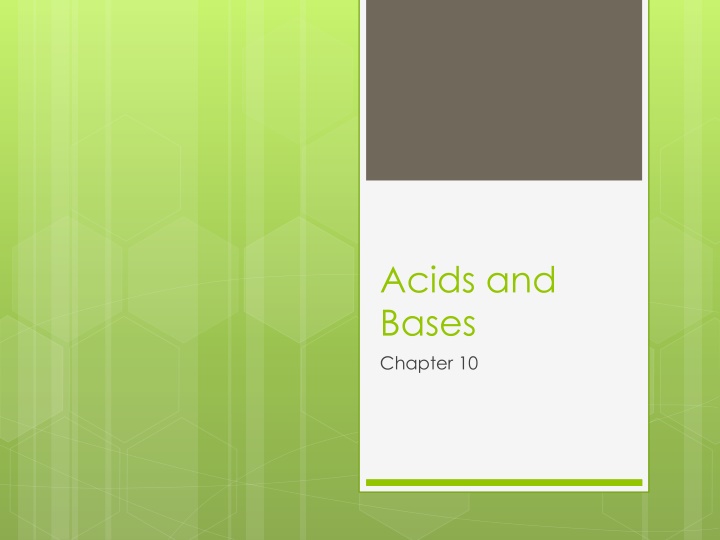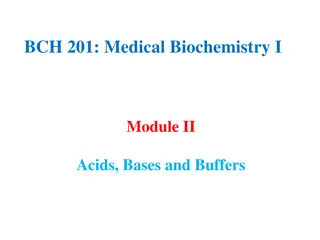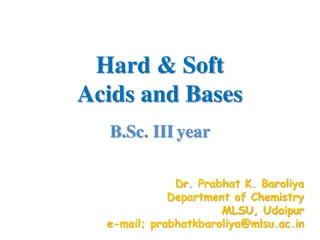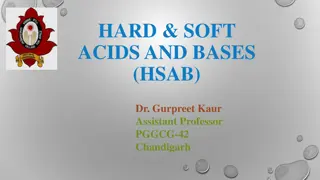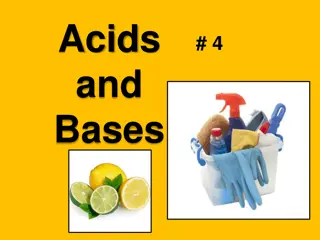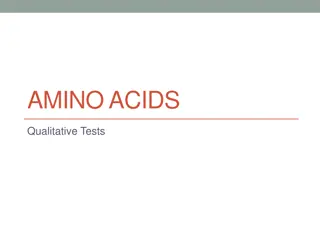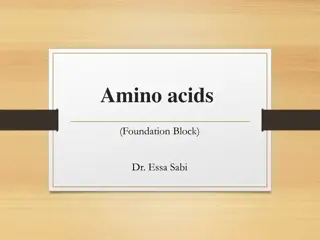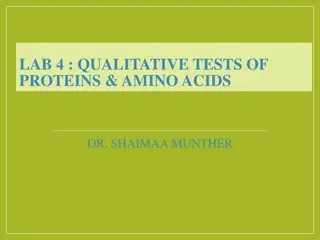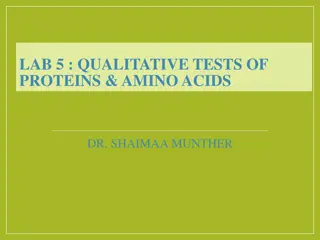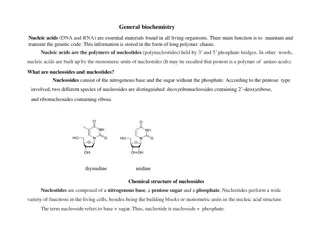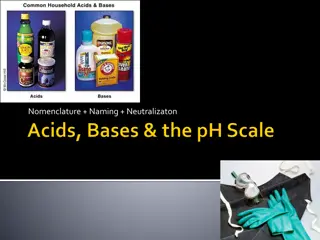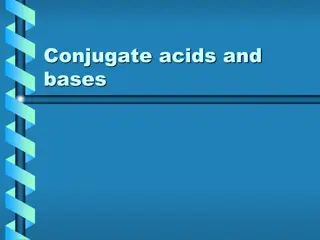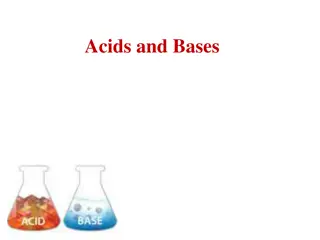Acids and Bases
Discover the fundamental principles of acids and bases in chemistry with a focus on theories, properties, and practical applications. Explore the significance of pH, acid-base reactions, and their role in various chemical processes. Dive into the nuances of acid-base equilibrium and understand key concepts through examples and real-world scenarios.
Download Presentation

Please find below an Image/Link to download the presentation.
The content on the website is provided AS IS for your information and personal use only. It may not be sold, licensed, or shared on other websites without obtaining consent from the author.If you encounter any issues during the download, it is possible that the publisher has removed the file from their server.
You are allowed to download the files provided on this website for personal or commercial use, subject to the condition that they are used lawfully. All files are the property of their respective owners.
The content on the website is provided AS IS for your information and personal use only. It may not be sold, licensed, or shared on other websites without obtaining consent from the author.
E N D
Presentation Transcript
Acids and Bases Chapter 10
Objectives Relate the process of ionization to the formation of acids and bases Explain qualities of acids and bases Compare the acidity of substances, using the pH scale and pH indicators Use molarity and titration to determine the concentration of an acid Contrast the concepts of strength and concentration in acids and bases Compare general qualities of acids and bases in foods Explain the importance of pH to physical health
Vocabulary Ionization: the process of forming ions in water solution Neutral: a solution that has an equal number of hydrogen and hydroxide ions Acid: a substance that breaks down to release hydrogen ions in water Base: a substance that breaks down to release hydroxide ions in water Neutralization: a chemical reaction in which hydrogen ions from an acid react with hydroxide ions from a base to produce water pH scale: a mathematical scale in which the concentration of hydrogen ions in a solution is expressed as a number from 0 to 14 Indicator: a substance that changes color depending on the pH Concentration: the measure of the amount of a substance in a given unit of volume Molarity: the number of moles of solute per liter of solution Titration: a common method used in the laboratory to determine the concentration of an acid and base Equivalence point: the point at which neutralization occurs Buffers: substances that help maintain the balance of hydrogen and hydroxide ions in a solution
Acids and Bases Video http://www.youtube.com/watch?v=DupX DD87oHc
Ionization of Water In water, a very small portion of molecules form tiny charged particles called ions When water ionizes, both hydrogen (H+) and hydroxide (OH-) ions are formed H2O H+ + OH-
Strength of Acids and Bases Strong acids and bases ionize completely Strong acid example: hydrochloric acid Weak acids and bases ionize partially Weak acid example: Acetic acid, found in potato salad
Neutralization of Acids and Bases If you add base to an acid, it adds hydroxide ions becomes a weaker acid and raises the pH If you add acid to a base, it adds hydrogen ions becomes a weaker base and lowers the pH Neutralization occurs when there are equal numbers of hydrogen and hydroxide ions
General Properties Acids Sour taste (ex: lemons) Can change the colors of certain foods and flowers (ex: Hydrangeas turn blue when planted in acidic soil) Bases Bitter taste (ex: milk of magnesia) Slippery (ex: soap, ammonia)
pH Scale Acids: pH between 0 and 7 Lower pH numbers indicate stronger acid Bases: pH between 7 and 14 Higher pH numbers indicate stronger bases Neutral: pH of 7 Determined by indicators and meters Ex: litmus paper soaked in anthocyanin
Acids and Bases in Foods Most bases in foods are strong, but with low concentration, so they are safe Most acids in foods are weak acids, so they are generally safe May sting eyes or open cuts (ex: citrus fruits) Very few foods have pH of exactly 7 Except distilled water pH balance is essential in making baked goods rise
Acids and Bases in the Body Blood must have balanced pH Not affected by pH of foods Regulated by buffers Digestive system requires a highly acidic environment to digest food Between 1.5 and 1.7 pH Gastric acid is mostly hydrochloric acid Antacids help neutralize stomach acid
